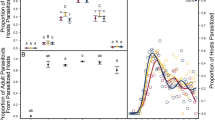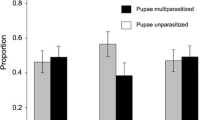Abstract
In an insect host (the cowpea weevilCallosobruchus maculatus)- parasitoidHeterospilus prosopidis) experimental system, the population densities of the component species oscillated for the first 20 generations and then abruptly stabilized as the parasitoid density decreased. Examination of the host and parasitoid after the 40th generation in the long-term experiment showed that (1) host larvae exhibited contest-type competition (killing other larvae inhabiting the same bean), in contrast to the founder population being scramble-type competitors and (2) the parasitoid attack rate on the host did not change. There was also an evolutionary trade-off between body size and the rates of larval survival and development, suggesting a cost of contest competition on larval survivorship and development. I tested model predictions (Tuda and Iwasa 1998) that (1) host equilibrium population size should gradually decrease as the proportion of the contest type increases and that (2) random attacks of the parasitoid on the host should reduce the rate of increase in proportion of the contest type, and the effect should become manifest especially during the first 20 generations. Two of three host-only replicates showed significant decrease in population sizes. Although the density of emerging adults per bean did not differ between replicates of the host-only and host-parasitoid systems, comparison of the host body size between them on day 270 (at the 13th generation) showed that the host was more contest-type in the host-only system than in the host-parasitoid system, as the model predicted, and later on day 650 the effect of the parasitoid had disappeared.
Similar content being viewed by others
References
Brakefiled, P. M. (1987) Industrial melanism: do we have the answers?Trends in Ecology and Evolution 2: 117–122.
Credland, P. F., K. M. Dick and A. W. Wright (1986) Relationships between larval density, adult size and egg production in cowpea seed beetle,Callosobruchus maculatus.Ecological Entomology 11: 41–50.
Dick, K. M. and P. F. Credland (1984) Egg production and development of three strains ofCallosobruchus maculatus F. (Coleoptera: Bruchidae).Journal of stored Product Research 20: 221–227.
Ellner, S., D. W. Nychka and A. R. Gallant (1992) LENNS, a program to estimate the dominant Lyapunov exponent of noisy nonlinear systems from time series data.Institute of Statistics Mimeo Series #2235 (BMA Series #39), Statistics Department, North Carolina State University, Raleigh NC 27695–8203.
Nicholson, A. J. (1954) An outline of the dynamics of animal populations.Australian Journal of Zoology 2: 9–65.
Nicholson, A. J. (1957) The self-adjustment of populations to change.Cold Spring Harbor Symposium in Quantitative Biology 22: 153–73.
Reznick, D. N., H. Bryga and J. A. Endler (1990) Experimentally induced life-history evolution in a natural population.Nature 346: 357–359.
Roff, D. A. (1992)The evolution of life histories; theory and analysis. Chapman & Hall, New York.
Smith, R. H. (1990) Adaptations ofCallosobruchus species to competition. pp. 351–360.In K. Fujii, A. M. R. Gatehouse, C. D. Johnson, R. Mitchel and T. Yoshida (eds.)Bruchids and legumes: economics, ecology and coevolution. Kluwer, the Netherlands.
Stearns, S. C. (1983) The genetic basis of differences in life-history traits among six stocks of mosquitofish that shared ancestors in 1905.Evolution 37: 618–627.
Stearns, S. C. (1992)The evolution of life histories. Oxford University Press, Oxford.
Stokes, T. K., W. S. C. Gurney, R. M. Nisbet and S. P. Blythe (1988) Parameter evolution in a laboratory insect population.Theoretical Population Biology 34: 248–265.
Thanthianga, C. and R. Mitchell (1987) Vibration mediate prudent resource exploitation by competing larvae of the bruchid bean weevilCallosobruchus maculatus.Entomologia Experimentalis et Applicata 44: 15–21.
Toquenaga, Y. and K. Fujii (1990) Contest and scramble competition inCallosobruchus maculatus (Coleoptera: Bruchidae). I. Larval competition curves and resource sharing patterns.Researches on Population Ecology 32: 199–211.
Toquenaga, Y., M. Ichinose, T. Hoshino and K. Fujii (1994) Contest and scramble competitions in an artificial world: Genetic analysis with GA. pp. 177–99.In C. G. Langton (ed.)Artificial Life III. Addison-Wesley.
Tuda, M. (1996) Temporal/spatial structure and the dynamical property of laboratory host-parasitoid systems.Researches on Population Ecology 38: 133–140.
Tuda, M. and Y. Iwasa (1998) Evolution of contest competition and its effect on host-parasitoid dynamics.Evolutionary Ecology 12: (in press).
Tuda, M. and M. Shimada (1995) Developmental schedules and persistence of experimental host-parasitoid systems at two different temperatures.Oecologia 103: 283–291.
Zar, J. H. (1984)Biostatistical analysis, 2nd edn. Prentice-Hall, New Jersey.
Author information
Authors and Affiliations
Corresponding author
Rights and permissions
About this article
Cite this article
Tuda, M. Evolutionary character changes and population responses in an insect host-parasitoid experimental system. Res Popul Ecol 40, 293–299 (1998). https://doi.org/10.1007/BF02763461
Received:
Accepted:
Issue Date:
DOI: https://doi.org/10.1007/BF02763461




